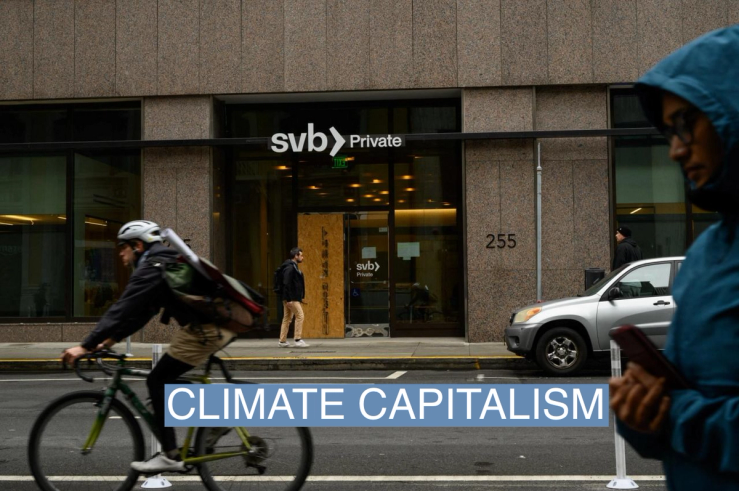The Scene
Just before her low-carbon cement company’s third anniversary, as Leah Ellis was climbing the stage to speak on a panel at the CERAWeek energy conference in Houston last week, her phone started blowing up with people telling her to pull the business’s money out of Silicon Valley Bank.
Sublime Systems had just closed a $40 million Series A fundraising round, cash that was parked in SVB. And Ellis’s company was in the middle of negotiating a loan from the bank to scale up its manufacturing operations enough to be cost-competitive with traditional cement.
“In three years we’ve scaled from a gram to 100 tons a year,” she said. “I kept thinking how catastrophic it would be if that was all lost for no reason.”
A government backstop meant Sublime Systems could get its money, but its chances at the loan are uncertain. The factory Ellis wants to build could cost up to half a billion dollars, a prospect that was already daunting enough before the SVB debacle. Indeed, the collapse comes at a bad time for many climate tech companies — one of SVB’s core constituencies. They are racing to scale up and accelerate the energy transition, all while fighting macroeconomic headwinds including inflation, rising interest rates, and supply chain bottlenecks.
Tim’s view
Many climate tech companies, especially those working on renewable energy projects, have high capital requirements: They’re building factories, solar farms, or other big infrastructure that is expensive and typically financed by debt. The past decade — an era of unusually low interest rates — improved projects’ profit margins and helped make nascent tech commercially viable.
That’s changing. The U.S. Federal Reserve is expected to raise rates up to 5.5% this year, and other global central banks are following suit, after several years in which they were close to zero. Costs for steel and other materials are also rising. So climate tech was already seeing its returns and financing options squeezed before the SVB collapse.
“Everything is getting squished in,” said Tom Chi, founding partner at At One Ventures in San Francisco. “Some of that is healthy because it makes you more disciplined, but it’s a little past healthy at this point.”
Because of its institutional understanding of and commitment to climate tech, SVB was often willing and able to offer financing, on better terms, for projects that other banks shied away from. It was the sixth-largest financier of U.S. renewable energy projects in 2022, at $1.2 billion, and planned to offer $5 billion in financing by 2027 to all kinds of climate-related enterprises. Those statistics probably underplay its role in climate tech, since it was especially known as a bank for smaller startups, and served more than 1,500 climate and sustainability companies.
SVB had more insight than most banks into which types of startups were most likely to secure additional venture funding, which gave it a more nuanced view of risk. Ellis said it helped that individual bankers, such as climate and energy VP Danny Donovan, were a fixed presence at climate tech conferences and had at least half the industry on speed dial, often even financing founders’ personal mortgages. SVB also didn’t have business with fossil fuel companies, which some founders I spoke to cited as another reason, in the interest of minimizing their indirect carbon footprints, they chose it over bigger banks.
SVB was one of the only places climate tech companies could turn for venture debt, a form of short-term lending for companies without assets to offer as collateral, a service Ellis and many of her peers saw as indispensable. It’s not clear exactly how much of the venture debt that the bank had extended to climate tech companies, but which was as yet untapped, remains available, although several VCs I spoke to said companies they had invested in, like Sublime Systems, were now scrambling for alternatives. That will be challenging, because these loans are typically tied to the completion of a new fundraising round.
The upshot is that even though startups’ cash may be protected by U.S. government guarantees, without SVB the climate tech financing landscape will be more constricted than it already was.
Quotable
“I would guess the SVB collapse will cause a one to two-quarter delay on a lot of things in climate tech. That doesn’t sound like a lot, but when you look at how much needs to get deployed in the next decade, losing half a year is really not good.” — Peter Reinhardt, CEO of carbon sequestration startup Charm Industrial, which banked at SVB.
Room for Disagreement
If climate tech is facing new headwinds, it is also being propelled by unprecedented tailwinds, particularly from the Inflation Reduction Act, the U.S.’s mammoth green support program. The tax code has never been as favorable for the development and marketing of low-carbon technology. Unlike some of the more speculative crypto or fintech startups with accounts at SVB, climate startups there tended to be those that had already passed muster with VCs as being on a clear path to compete head-on with high-carbon incumbent technologies. Strong businesses, in other words, won’t lack banking suitors, and other banks will surely step in to win SVB’s clients.
Rising interest rates also work to the advantage of startups focused on energy efficiency, to the extent these companies help other businesses cut their overhead costs. Electric utilities, in particular, are facing their own mounting multi-billion-dollar upgrade costs and are desperate for solutions to avoid a complete overhaul of the grid that they can’t afford, according to Lisa Lambert, president of National Grid Partners, the venture wing of the electric utility that serves New York and Massachusetts.
“It could be really disastrous for the country’s infrastructure if these kinds of startups don’t get funded,” she said.
The View From Red States
Several VCs I spoke to emphasized that as more climate tech companies move from the lab to commercial scale, they are spreading from liberal startup hubs like San Francisco and Boston into conservative states with favorable tax codes for manufacturing. Among those firms are SVB clients like Ascend Elements, which is building a $1 billion battery recycling facility in Kentucky, and Monarch Tractor, which is building autonomous, electric farming vehicles in Ohio. Those companies can’t continue to grow and hire if they can’t access capital.
“It’s a Silicon Valley bank, but not a Silicon Valley problem,” Avra van der Zee, COO at Elemental Excelerator, a nonprofit climate tech investor, told me.
Notable
- One of SVB’s highest-profile climate clients was solar developer Sunrun, whose stock price fell to its lowest point since October over the weekend. It hasn’t bounced back yet, but its CEO told Bloomberg that on Friday, “a lot of other financial institutions were reaching out for our business.”


